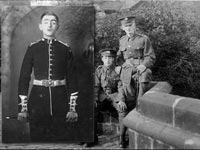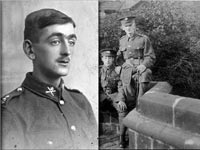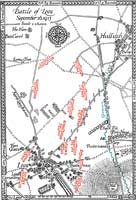
'THE GREAT WAR', 'THE WAR TO END WAR', 'WORLD WAR 1'
1914 - 1918
 |
EDWARD GARSIDE WHITEHEAD Guardsman 21718, 4th BATTALION GRENADIER GUARDS: Service No. 385 GUARDS MACHINE-GUN CORPS No. 2 Company Killed in Action 31st July 1917 3rd Battle of Ypres (Passchendaele) |
 |
With many page transcriptions from 'The Grenadier Guards in the Great War of 1914-1918' by Sir Frederick Ponsonby, to recount the actual organisation & battles in which the Grenadiers, in particular the 4th Battalion, took part. Pub. 1920 in 3 Volumes, . from Volume 1 |
|
|
Part 2 ... Narrative Parts Index On the 20th of July the newly created 4th Battalion had set off for Bovingdon Camp and their last few weeks of training before embarking at Southhampton, on the 'Empress Queen', for Havre in France. On arrival they entrained for St. Omer, then marched to Blendecques. there they would remain until the newly created Guards Division came into being in September, and they were thrown straight into action when the Battle of Loos began on the 25th September ... Edward himself would not cross to Fance, with a draft of soldiers, and join the 4th battalion until the battle was virutally over, transcripts : |
|
p. 290-291 ~~~~~~~~~~~~~~~~~~~~~~~~~~~~~~~~~~~~~~~~~~~~~~~~~~~~~~~~~~~~~~~~ BATTLE of LOOS, 1915
|
|
Sept. 25th |
It was arranged that the First Corps, consisting of the Second, Seventh, and Ninth Divisions, under Lieut.-General Hubert Gough, should attack the line between La Bassée Canal and Vermelles, while the Fourth Corps (First, Fifteenth, and Forty-seventh Divisions), under Lieut.-General Sir H. Rawlinson, attacked from Vermelles to Grenay, the Hulluch-Vermelles road forming the boundary between the two Corps |
Sept. 1915 |
~~~~~~~~~~~~~~~~~~~~~~~~~~~~~~~~~~~~~~~~~~~~~~~~~~~~~~~~~~~~~~~~
p. 292 The attack began at 6.30am on September 25, after four days' continuous bombardment by our massed guns. Gas was employed, but unfortunately the wind was unfavourable, and it moved so slowly that it retarded the advance. Further, the wire in some places had hardly been touched, and consequently the Second Division was held up from the start. Meanwhile the Ninth Division started well, and even managed to reach the northern end of "Little Willie," but was unable to maintain its advanced position on account of the check to the Second Division. The Seventh Division captured the first line of the trenches and cleared the quarries half-way between the front line and Cité St. Elie, while the leading troops even penetrated as far as Cité St. Elie itself. By mid-day the First Corps had secured the whole of the German front from the Hohenzollern Redoubt southwards and had pushed forward to the second line at three points. But in this achievement it suffered heavy casualties, and was left too weak to do more than hold on to the position it had gained. In the Fourth Corps the First Division swept forward, carried the first two lines of German trenches, and reached the outskirts of Hulluch, where it waited for reinforcements, but as these did not arrive it had to fall back on the Lens - La Bassée road. As for the Fifteenth Division, whose objective was Cité St. Augusté, it pushed through not only to Loos, but even over Hill 70, and the 4th Brigade in this division actually reached the outskirts of Cité St. Laurent. |
Sept. 26th - 27th |
~~~~~~~~~~~~~~~~~~~~~~~~~~~~~~~~~~~~~~~~~~~~~~~~~~~~~~~~~~~~~~~~ p. 293-294 On the afternoon of the 26th the Eleventh Corps was placed at the disposal of Sir Douglas Haig; it consisted of the Guards Division and the Twenty-first and Twenty-fourth Divisions. The two latter were at once hurried up into the firing line, the Twenty-first Division sending two brigades to Loos while the Twenty-fourth went to the Lens - La Bassée road. Throughout that Sunday the fighting was very severe, and it was only with the greatest difficulty that we held on to Loos. The First Corps was also being strongly counter-attacked, and the quarries changed hands several times. All day the Crown Prince of Bavaria, who was in command of the army facing the British divisions, was engaged in bringing up reserves from other parts, and by next day he had strengthened his whole line. The German line ran from Auchy - La Bassée over comparatively flat country to the Vermelles - Hulluch road, where the ground became undulating and culminated in Hill 70. Early on Monday the advance was renewed, but the Germans had started counter-attacking, and a confused struggle went on, with varying success. Several times our line gave way, only to be rallied and go forward again. We managed to maintain our ground on the right and centre of Hill 70, but on the extreme left the enemy pressed the line back towards Loos. In the meantime the 64th Brigade of the Twenty-fourth Division was being driven back and subjected to withering enfilade fire. The line from the Chalk Pit to the northern end of Hill 70 had to be abandoned, and Loos was thus left exposed to an attack from the north-east. A brigade of the Third Cavalry Division was then brought up to reinforce the hard-pressed troops who were holding Loos. |
The Guards Division |
~~~~~~~~~~~~~~~~~~~~~~~~~~~~~~~~~~~~~~~~~~~~~~~~~~~~~~~~~~~~~~~~ p. 294 continued The Guards Division The Guards Division arrived early on Sunday morning at Haillicourt, more than ten miles off, and marched through Noeux-les-Mines and Sailly-la-Bourse to Vermelles. For the first time since its creation the Guards Division was to go into action, and naturally, after the fame individual battalions had won in the earlier part of the war, a great deal was expected of it. All the troops were cheered by the news that the Division had arrived and was going in, but the situation had altered a good deal since the attack was first launched. All element of surprise had disappeared, and the Germans had had time to recover from the effects of the first blow and to collect reinforcements. It is doubtful whether the Guards Division ever had any real chance of succeeding in its attack. It had to start from old German trenches, the range of which the German artillery knew to an inch, while the effect of our own original artillery bombardment had died away. However, there was no alternative but to put in the Guards Division and try and regain as much of the lost ground as possible. Major-General Lord Cavan sent round on the 25th a stirring message to the men, reminding them that great things were expected of the Division, and they were full of confidence as they went into action. |
The Guards Division Sept. 1915 |
~~~~~~~~~~~~~~~~~~~~~~~~~~~~~~~~~~~~~~~~~~~~~~~~~~~~~~~~~~~~~~~~ p. 295 The easiest task fell to the lot of the 1st Guards Brigade, under Brigadier General Feilding, on the left. It was to advance in the direction of the Bois Hugo and straighten the line, so that it would run parallel to the Lens - La Bassée road. The 2nd Brigade, under Brigadier-General Ponsonby, was to take and hold the Chalk Pit and Puits 14 bis, and the 3rd Brigade, under Brigadier-General Heyworth, to advance against Hill 70. But to a large extent the movements of the lst and 3rd Brigades depended on the success of the attack of the 2nd Brigade. Accomplishing their work at once, Feilding's Brigade secured a good position on the ground over which the Twenty-fourth Division had retired. General Feilding, who understood that he was to assist the other brigades by fire as far as possible, at once collected as many smoke-bombs and smoke-candles as he could, and at zero hour formed a most effective smoke-screen, which drew off the fire of a great many German guns from the other attackers. Success at first also attended the attack of Ponsonby's Brigade. It took the Chalk Pit and Puits 14, bis, but then a tremendous fire from machine-guns in Bois Hugo swept it down, and it was unable to keep its hold on these positions. This made it very difficult for the other brigades to move forward. But on learning that Ponsonby's Brigade was fighting furiously for the possession of the Chalk Pit, Lord Cavan decided |
The Guards Division Sept. 1915 |
~~~~~~~~~~~~~~~~~~~~~~~~~~~~~~~~~~~~~~~~~~~~~~~~~~~~~~~~~~~~~~~~ p. 296-297 that the only way to relieve the strain on them was to order Heyworth's Brigade to advance. It did so, and this course proved successful in enabling Ponsonby's Brigade to retain possession of the Chalk Pit. Going forward, Heyworth's Brigade took Hill 70, but it too found it impossible to keep what it had won. The enemy's trenches were marked on the map as being on the crest of the hill, but in reality they were on the reverse slope, and had never been touched by shell-fire. The net result of the attack of the Guards Division was the establishment of the British front along a line running, roughly, northward from the south-eastern end of Loos and parallel to the Lens-La Bassée road. Another attempt to gain Puits 14 was made by the lst Battalion Coldstream on the 28th, but was no more successful than the first. As before, a small party reached the Puits, but was driven out again by enfilade fire. Measured by the length of the advance made during the battle and the extent of ground taken from the enemy, the results of the battle of Loos would seem distinctly disappointing, more especially when the casualty list of 45,000 men is considered. But to estimate these operations in terms of geography is a mistake. The smallness of the theatre of operations and the comparatively narrow depth of our advance give a totally misleading impression of the success of the battle. It is obviously more valuable to put out of action 50,000 Germans and gain half a mile than to gain live miles and only inflict a loss of 10,000. when it is realised that we drove the enemy from positions which they considered impregnable to the assaults of modern weapons, that their casualties must have been as heavy as, if not heavier than, our own, and that we took 3000 prisoners (including 50 officers), 26 field-guns, and 40 machine- guns, - it will be seen that Lord Kitchener's description of the battle as a substantial success was not very far wide of the mark. ~~~~~~~~~~~~~~~~~~~~~~~~~~~~~~~~~~~~~~~~~~~ Next part |
Part 1 * Edward enlists in Jan.1915; Transcripts: * formation of the 4th Battn. * Guards Division in 1915. |
|||
Part 4 Edward lands in France Oct. Transcripts: * Diary of the War- Oct., Nov., Dec., 1915; * 4th Battn. Oct - Dec |
Part 5 Edward transfers to Machine-Gun Guards Transcripts: * Diary of the War - Jan - Sept. 1916; * 4th Battn. Jan - Apr. 1916 |
||
Part 9 Transcripts: * Diary of the War - Oct to Dec 1916: * 4th Battn - Oct - Nov 1916; * Diary of the War - Jan - Mar 1917; * 4th Battn. Jan - Mar 1917 |
|||
Part 12 Transcripts: * Edward Killed in action in Battle of Boesinghe 31 July 1917 *3rd Battalion - Boesinghe 1st battalion - Boesinghe 4th battalion - Boesinghe |
Part 13
|
* Gallery of pictures & Maps |
|
'The Grenadier Guards in the Great War of 1914-1918' by Sir Frederick Ponsonby Pub. 1920 in 3 Volumes, is freely downloadable as .pdf files or can be read on-line. |
|||
Vol 1 HERE |
Vol 2 HERE |
Vol 3 HERE |
|
Contributed by Sheila Goodyear
World War 1 Project MENU PAGE |
Members' Pages MENU |
